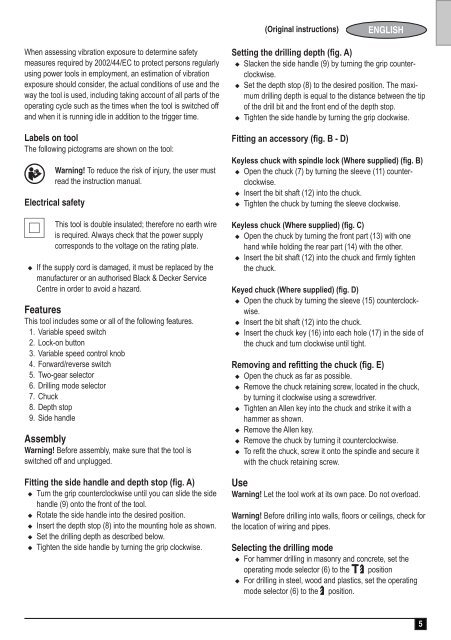BlackandDecker Perceuse- Kr1102 - Type 1 - Instruction Manual (Européen)
BlackandDecker Perceuse- Kr1102 - Type 1 - Instruction Manual (Européen)
BlackandDecker Perceuse- Kr1102 - Type 1 - Instruction Manual (Européen)
Create successful ePaper yourself
Turn your PDF publications into a flip-book with our unique Google optimized e-Paper software.
(Original instructions)<br />
ENGLISH<br />
Wh<strong>en</strong> assessing vibration exposure to determine safety<br />
measures required by 2002/44/EC to protect persons regularly<br />
using power tools in employm<strong>en</strong>t, an estimation of vibration<br />
exposure should consider, the actual conditions of use and the<br />
way the tool is used, including taking account of all parts of the<br />
operating cycle such as the times wh<strong>en</strong> the tool is switched off<br />
and wh<strong>en</strong> it is running idle in addition to the trigger time.<br />
Labels on tool<br />
The following pictograms are shown on the tool:<br />
:<br />
Warning! To reduce the risk of injury, the user must<br />
read the instruction manual.<br />
Electrical safety<br />
#<br />
This tool is double insulated; therefore no earth wire<br />
is required. Always check that the power supply<br />
corresponds to the voltage on the rating plate.<br />
u If the supply cord is damaged, it must be replaced by the<br />
manufacturer or an authorised Black & Decker Service<br />
C<strong>en</strong>tre in order to avoid a hazard.<br />
Features<br />
This tool includes some or all of the following features.<br />
1. Variable speed switch<br />
2. Lock-on button<br />
3. Variable speed control knob<br />
4. Forward/reverse switch<br />
5. Two-gear selector<br />
6. Drilling mode selector<br />
7. Chuck<br />
8. Depth stop<br />
9. Side handle<br />
Assembly<br />
Warning! Before assembly, make sure that the tool is<br />
switched off and unplugged.<br />
Fitting the side handle and depth stop (fig. A)<br />
u Turn the grip counterclockwise until you can slide the side<br />
handle (9) onto the front of the tool.<br />
u Rotate the side handle into the desired position.<br />
u Insert the depth stop (8) into the mounting hole as shown.<br />
u Set the drilling depth as described below.<br />
u Tight<strong>en</strong> the side handle by turning the grip clockwise.<br />
Setting the drilling depth (fig. A)<br />
u Slack<strong>en</strong> the side handle (9) by turning the grip counterclockwise.<br />
u Set the depth stop (8) to the desired position. The maximum<br />
drilling depth is equal to the distance betwe<strong>en</strong> the tip<br />
of the drill bit and the front <strong>en</strong>d of the depth stop.<br />
u Tight<strong>en</strong> the side handle by turning the grip clockwise.<br />
Fitting an accessory (fig. B - D)<br />
Keyless chuck with spindle lock (Where supplied) (fig. B)<br />
u Op<strong>en</strong> the chuck (7) by turning the sleeve (11) counterclockwise.<br />
u Insert the bit shaft (12) into the chuck.<br />
u Tight<strong>en</strong> the chuck by turning the sleeve clockwise.<br />
Keyless chuck (Where supplied) (fig. C)<br />
u Op<strong>en</strong> the chuck by turning the front part (13) with one<br />
hand while holding the rear part (14) with the other.<br />
u Insert the bit shaft (12) into the chuck and firmly tight<strong>en</strong><br />
the chuck.<br />
Keyed chuck (Where supplied) (fig. D)<br />
u Op<strong>en</strong> the chuck by turning the sleeve (15) counterclockwise.<br />
u Insert the bit shaft (12) into the chuck.<br />
u Insert the chuck key (16) into each hole (17) in the side of<br />
the chuck and turn clockwise until tight.<br />
Removing and refitting the chuck (fig. E)<br />
u Op<strong>en</strong> the chuck as far as possible.<br />
u Remove the chuck retaining screw, located in the chuck,<br />
by turning it clockwise using a screwdriver.<br />
u Tight<strong>en</strong> an All<strong>en</strong> key into the chuck and strike it with a<br />
hammer as shown.<br />
u Remove the All<strong>en</strong> key.<br />
u Remove the chuck by turning it counterclockwise.<br />
u To refit the chuck, screw it onto the spindle and secure it<br />
with the chuck retaining screw.<br />
Use<br />
Warning! Let the tool work at its own pace. Do not overload.<br />
Warning! Before drilling into walls, floors or ceilings, check for<br />
the location of wiring and pipes.<br />
Selecting the drilling mode<br />
u For hammer drilling in masonry and concrete, set the<br />
operating mode selector (6) to the<br />
s position<br />
u For drilling in steel, wood and plastics, set the operating<br />
mode selector (6) to the<br />
r position.<br />
5
















